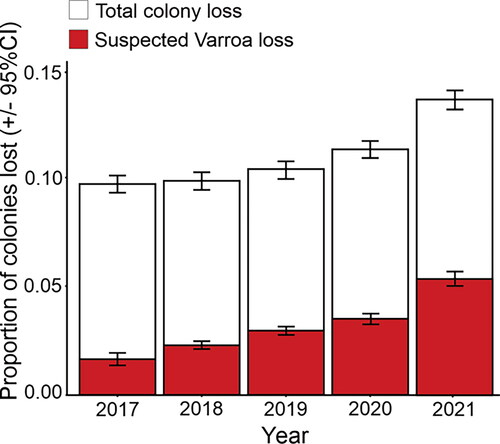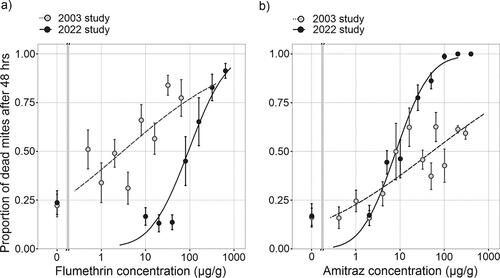Figures & data
Figure 1. The proportion of total colonies lost (± 95% CI) and colonies that beekeepers suspected were lost due to Varroa (± 95% CI) for the years 2017–2021 in New Zealand. Results are based on reports from all beekeepers that participated in the annual New Zealand colony loss survey. The number of bee colonies reported on each year ranged between 242,926 and 381,148.

Table 1. The most commonly utilised chemical treatments for Varroa as reported by commercial beekeepers in the annual colony loss survey in New Zealand from 2017–2021. The category “Other” contains control methods that aren’t already listed, such as thymol, fogging, drone brood removal and hyperthermia that were presented as treatment options in the New Zealand Colony Loss Survey. The number of beekeepers that answered the question on Varroa treatments is included in the table, as is the number of beekeepers who participated in the survey but chose not to answer the question.
Table 2. Efficacy of flumethrin and amitraz, the two most commonly utilised chemical treatments for Varroa, as reported by commercial beekeepers in the annual colony loss survey in New Zealand in 2021. Efficacy in controlling Varroa was categorised as either “completely successful”, “mostly successful”, “partly successful” or “not at all successful”. The responses are displayed as a proportion of all commercial beekeepers that reported using that chemical. For amitraz, 121 beekeepers reported on the success of the treatment, while 101 reported on the success of flumethrin.
Figure 2. Comparison of the average proportion (±1 SE) of Varroa killed at each chemical concentration in 2003 (Goodwin et al., Citation2005) and the current study for (a) flumethrin and (b) amitraz.

Table 3. Lethal concentrations for 50% mite mortality (LC50) with 95% confidence intervals (CI) of flumethrin and amitraz from the Goodwin study in 2003 and the current study. The results from the Goodwin study in 2003 were rerun and analysed in SPSS using an Abbott’s correction alongside the 2022 data, so differ slightly to what was reported in Goodwin et al. (Citation2005). The fit of the model was also analysed using chi-squared goodness of fit tests for both time periods.
Supplementary material.docx
Download MS Word (2.6 MB)Data availability statement
Data from the New Zealand Colony Loss Survey are not publicly available due to privacy concerns and potential commercial sensitivities. Data from the experiments testing for chemical resistance presented in this study are available on request from the corresponding author.
